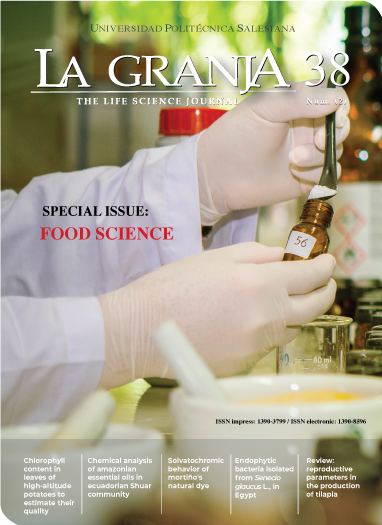Solvatochromic behavior of the natural colorant of blueberry (Vaccinium floribundum Kunth)
Main Article Content
Abstract
Article Details

This work is licensed under a Creative Commons Attribution-NonCommercial-ShareAlike 4.0 International License.
Universidad Politécnica Salesiana of Ecuador preserves the copyrights of the published works and will favor the reuse of the works. The works are published in the electronic edition of the journal under a Creative Commons Attribution/Noncommercial-No Derivative Works 3.0 Ecuador license: works can be copied, used, disseminated, transmitted and publicly displayed.
The undersigned author partially transfers the copyrights of this work to Universidad Politécnica Salesiana of Ecuador for the printed edition.
References
Almachi D. Suarez, M. (2018). «Estudio de la influencia de colorantes naturales sobre el color y las propiedades reológicas de una formulación alimenticia». Tesis de maestría. Universidad Central del Ecuador.
Arteaga, M., M. Andrade y C. Moreno (2014). «Relación del desarrollo del color con el contenido de antocianinas y clorofila en diferentes grados de madurez de mortiño (Vaccinium floribundum)». En: Enfoque UTE 5.2, 14-28. Online: https://n9.cl/4tu14.
Ayala, K. y col. (2018). «Toxicidad de los colorantes sintéticos: de lo global al Ecuador». En: Revista Biorrefinería 1.1, 40-48. Online: https://n9.cl/kpepv.
Belmonte, J. y col. (2016). «Colorantes artificiales en alimentos». En: Revista Naturaleza Y Tecnología Universidad de Guanajuato 10.8, 24-38. Online: https://n9.cl/8z4rr.
Buchweitz, M. y col. (2013). «Impact of pectin type on the storage stability of black currant (Ribes nigrum L.) anthocyanins in pectic model solutions». En: Food chemistry 139.1-4, 1168-1178. Online: https://n9.cl/z7256.
Cai, L. y col. (2020). «A solvatochromic AIE tetrahydro [5] helicene derivative as fluorescent probes for water in organic solvents and highly sensitive sensors for glyceryl monostearate». En: Talanta 206, 0039-9140. Online: https://n9.cl/z7256.
Casaubon, P. y col. (2018). «pH de los alimentos: ¿una herramienta para el manejo de los pacientes con reflujo gastroesofágico?» En: Revista Mexicana de Pediatría 85.3, 89-94. Online: https://n9.cl/nkyvf.
Castañeda-Ovando A. Pacheco-Hernández, M. y col. (2009). «Chemical studies of anthocyanins: A review». En: Food chemistry 113.4, 859-871. Online: https://n9.cl/8nvxi.
Enaru, B. y col. (2021). «Anthocyanins: Factors affecting their stability and degradation». En: Antioxidants 10.12, 1967. Online: https://n9.cl/wtuvw.
Garzón, G. (2008). «Anthocyanins as natural colorants and bioactive compounds: A review». En: Acta Biológica Colombiana 13.3, 27-36. Online: https://n9.cl/e31th.
Iosub, S., A. Meghea e I. Geana (2014). «Solvatochromic parameters of some anthocyanin derivatives concentrated from selective natural extracts». En: UPB Scientific Bulletin, Series B: Chemistry and Materials Science 76.1, 25-34. Online: https://n9.cl/q9lcm.
Jin, W. y col. (2020). «Study on the coupling progress of thermo-induced anthocyanins degradation and polysaccharides gelation». En: Food Hydrocolloids 105, 105822. Online: https://n9.cl/t4p9w.
Kader, F. y col. (1998). «Degradation of cyanidin 3-glucoside by blueberry polyphenol oxidase: kinetic studies and mechanisms». En: Journal of agricultural and food chemistry 46.8, 3060-3065. Online: https://pubag.nal.usda.gov/catalog/1371074.
Klymchenko, A. (2017). «Solvatochromic and fluorogenic dyes as environment-sensitive probes: design and biological applications». En: Accounts of chemical research 50.2, 366-375. Online: https://n9.cl/dqp7t.
Koh, J., Z. Xu y L. Wicker (2020). «Binding kinetics of blueberry pectin-anthocyanins and stabilization by non-covalent interactions». En: Food Hydrocolloids 99, 105354. Online: https://n9.cl/gybb5.
Lee, J. y col. (2013). «A protective layer approach to solvatochromic sensors». En: Nature Communications 4.1, 2461. Online: https://n9.cl/oa2lc.
Linying, L. y col. (2022). «Study on the origin of linear deviation with the Beer-Lambert law in absorption spectroscopy by measuring sulfur dioxide». En: Spectrochimica Acta Part A: Molecular and Biomolecular Spectroscopy 275, 121192. Online: https://n9.cl/2qg80.
Loving, G., M. Sainlos y B. Imperiali (2010). «Monitoring protein interactions and dynamics with solvatochromic fluorophores». En: Trends in biotechnology 28.2, 73-83. Online: https://n9.cl/rii2t.
Marini, A. y col. (2010). «What is solvatochromism?» En: The Journal of Physical Chemistry B 114.51, 17128 17135. Online: https://n9.cl/lvkye.
Mayerhöfer, T. y J. Popp (2020). «Beyond Beer’s Law: Revisiting the Lorentz-Lorenz Equation ». En: ChemPhysChem 21.12, 1218-1223. Online: https://n9.cl/h4cw5.
Narváez, G y M Suárez (2016). «Estabilización de las antocianinas presentes en el fruto de mortiño (Vaccinium floribundum Kunth) mediante el método de copigmentación intermolecular para la obtención de pigmentos antociánicos con potencial aplicación en la industria farmacéutica y cosmé». Tesis de maestría. Universidad Central del Ecuador.
Nguyen, T. y col. (2018). «Encapsulation of Hibiscus sabdariffa L. anthocyanins as natural colours in yeast». En: Food research international 107, 275-280. Online: https://n9.cl/g8yca.
Pubchem (2022). Malvidin 3-Glucoside.
Putra, N. y col. (2023). «Optimization and solubilization of interest compounds from roselle in subcritical ethanol extraction (SEE)». En: Alexandria Engineering Journal 65, 59-74. Online: https://n9.cl/g1igc.
Rahman, S. y col. (2021). «Health benefits of cyanidin-3-glucoside as a potent modulator of Nrf2-mediated oxidative stress». En: Inflammopharmacology 29, 907-923. Online: https://n9.cl/6bhp6.
Reichardt, C. (1994). «Solvatochromic dyes as solvent polarity indicators». En: Chemical reviews 94.8, 2319-2358. Online: https://n9.cl/vcpl6.
Sánchez, J. (2013). «La química del color en los alimentos». En: Química Viva 12.3, 234-246. Online: https://n9.cl/jbcd2.
Torres, F. y N. Pulgar (2017). «Evaluación de la estabilidad del pigmento natural obtenido a partir de mortiño (Vaccinium myttillus L) como colorante para la industria de alimentos». En: SATHIRI 12.1, 171-186. Online: https://n9.cl/9fim7.
Vasco, C. y col. (2009). «Chemical composition and phenolic compound profile of mortiño (Vaccinium floribundum Kunth)». En: Journal of Agricultural and Food Chemistry 57.18, 8274-8281. Online: https://n9.cl/es/s/nrbxl.
Xu, M. y col. (2010). «Cyanidin-3-glucoside inhibits ethanol-induced invasion of breast cancer cells overexpressing ErbB2». En: Molecular cancer 9.1, 1-14. Online: https://n9.cl/byd7l.
Yépez, M. y Suaárez (2019). «Adición de antocianinas extraídas del fruto de Vaccinium floribundum Kunth y antocianinas estabilizadas en nanopartículas de zeína en yogur natural, como alternativa a los colorantes de síntesis». Tesis de maestría. Universidad Centra del Ecuador.

